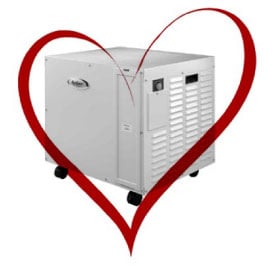 Unlike humidifiers which require a good amount of regular and diligent maintenance in order to keep them functioning properly and safely, dehumidifiers typically run for much longer periods before needing any service. Generally, most dehumidifiers require a small amount of annual maintenance, but skipping this can shorten the lifespan of your investment.
Unlike humidifiers which require a good amount of regular and diligent maintenance in order to keep them functioning properly and safely, dehumidifiers typically run for much longer periods before needing any service. Generally, most dehumidifiers require a small amount of annual maintenance, but skipping this can shorten the lifespan of your investment.
To keep your unit running at peak performance and potentially prevent it from becoming a fire hazard (any ill-maintained appliance can become one), here are some dehumidifier maintenance tips to keep in mind. Additionally, if you’re a property owner in Florida and your house’s or current space’s fire alarm system and/or water-based fire protection system such as a sprinkler system is inoperational, you are required by the National Fire Protection Association (NFPA) and Florida Statute to implement a fire watch should that system become impaired. You may seek expert help from professional Fire Watch Services in Cocao Beach.
**ALWAYS UNPLUG UNIT BEFORE PERFORMING ANY KIND OF DEHUMIDIFIER MAINTENANCE**
Dehumidifier Maintenance Tips
- Read the user manual and follow manufacturer recommendations. Familiarize yourself with the unique features and requirements of your particular unit in order to care for its specific needs.
- Set up your dehumidifier properly. Make sure your unit is placed on a level surface and that there are no obstructions to its air intake. Blocked air intakes can cause the units to overheat and lead to increased fire hazard risk or premature failure.
- Check water levels daily. Nearly all units that collect condensate in a reservoir shut off when their water containers are full. However, if they are not emptied, the dehumidifier stops operating and your home humidity levels will begin to rise. In addition to this, water left sitting in the reservoir for long periods of time increases the risk of mold growth – which is exactly the sort of thing a dehumidifier is meant to control. For units that feature a hose option for drainage, check regularly to make sure water is draining properly. Ensure there are no kinks or blockages in the line.
- Clean the water reservoir / condensate bucket regularly. You need to periodically clean the water reservoir to prevent mold/microbe growth. As something that is continually exposed to moisture, the potential for microbes is high. You can clean the reservoir with Vital Oxide mold remover.
- Never store gas or other flammable liquids near your dehumidifier. This is a major fire hazard.
- Inspect power cords and replace when necessary. Make sure that the electrical cord you get is the same type and amperage. Never use a unit with a damaged power cord. While any electrical appliance can be a potential fire hazard, dehumidifiers tend to have a higher wattage and amperage, increasing risk of fire or shock when the cord is damaged.
- Regularly replace any filters. If your unit has any kind of filter, make sure to check it regularly and replace yearly or as necessary. Some are simple screens that can be rinsed while larger units use filters similar to an HVAC filter (which need to be replaced every 6-12 months). Again, check manufacturers instructions.
- Inspect and clean dehumidifier’s coils once per year. Coils should be free of dust. Clean them with a vacuum cleaner or a soft-bristle brush (not a wire one, since coils are typically constructed of softer metals, like aluminum or copper, and can be easily damaged). Coils should never be wet. When temperatures are cool under 60° Fahrenheit, make sure the coils are not icing up (Most dehumidifiers have an auto defrost/de-icer to eliminate this).
- Do not turn unit off and on quickly. Wait at least ten minutes after you turn the unit off in order to turn it on again. You will avoid short-circuiting the unit and prolong its life.
- Apply oil to motor as necessary and check pumps intermittently. This mainly applies to larger basement/crawlspace/industrial dehumidifiers, but is important nonetheless.
- Do not get touchpad wet when cleaning the exterior of your unit. Generally, you want to keep moisture away from the control panel. Simply clean with a dry microfiber cloth.
That pretty much takes care of your annual dehumidifier maintenance! A dehumidifiers is really a low maintenance device. Beyond some cleaning and filter replacement, the other common topic of question is regarding storage. Often people will use a dehumidifier during the spring and summer months when humidity is at its highest. Storing your dehumidifier during off use months is a relatively easy process for most home units. Simply clean as you normally would, ensure all water is out of the reservoir, and if your unit has a pump purge, do so at this time. Once this is complete, you’re ready for storage!
If you found these dehumidifier maintenance tips helpful and want to learn more about dehumidifiers, humidity, or controlling excess moisture, visit any of these Learning Center resources.
✔ Dehumidifier Buying Guide
✔ Mold FAQs
✔ Dehumidifier FAQs
✔ Dehumidifier Water Removal Options
✔ Common Types of Household Mold
✔ Winter Mold Allergies
